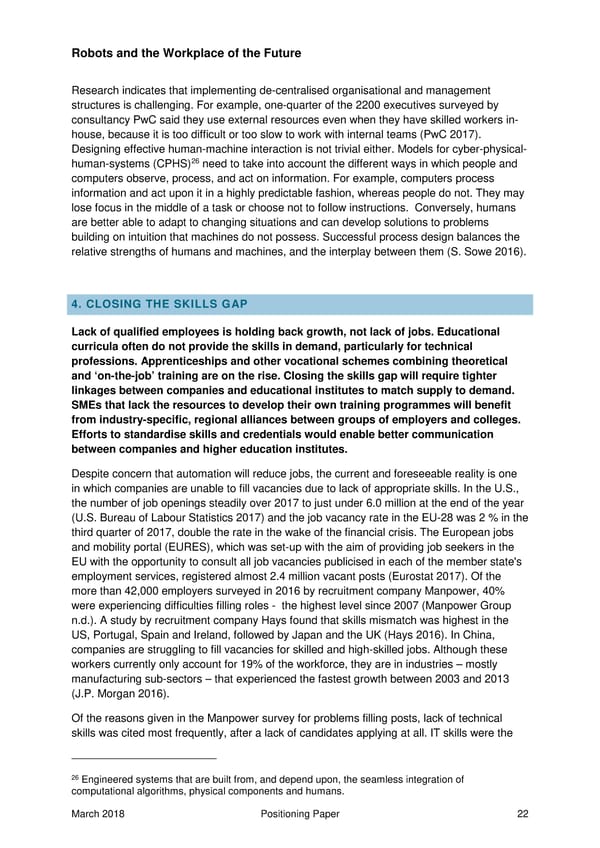Robots and the Workplace of the Future Research indicates that implementing de-centralised organisational and management structures is challenging. For example, one-quarter of the 2200 executives surveyed by consultancy PwC said they use external resources even when they have skilled workers in- house, because it is too difficult or too slow to work with internal teams (PwC 2017). Designing effective human-machine interaction is not trivial either. Models for cyber-physical- human-systems (CPHS)26 need to take into account the different ways in which people and computers observe, process, and act on information. For example, computers process information and act upon it in a highly predictable fashion, whereas people do not. They may lose focus in the middle of a task or choose not to follow instructions. Conversely, humans are better able to adapt to changing situations and can develop solutions to problems building on intuition that machines do not possess. Successful process design balances the relative strengths of humans and machines, and the interplay between them (S. Sowe 2016). 4. CLOSING THE SKILLS GAP Lack of qualified employees is holding back growth, not lack of jobs. Educational curricula often do not provide the skills in demand, particularly for technical professions. Apprenticeships and other vocational schemes combining theoretical and ‘on-the-job’ training are on the rise. Closing the skills gap will require tighter linkages between companies and educational institutes to match supply to demand. SMEs that lack the resources to develop their own training programmes will benefit from industry-specific, regional alliances between groups of employers and colleges. Efforts to standardise skills and credentials would enable better communication between companies and higher education institutes. Despite concern that automation will reduce jobs, the current and foreseeable reality is one in which companies are unable to fill vacancies due to lack of appropriate skills. In the U.S., the number of job openings steadily over 2017 to just under 6.0 million at the end of the year (U.S. Bureau of Labour Statistics 2017) and the job vacancy rate in the EU-28 was 2 % in the third quarter of 2017, double the rate in the wake of the financial crisis. The European jobs and mobility portal (EURES), which was set-up with the aim of providing job seekers in the EU with the opportunity to consult all job vacancies publicised in each of the member state's employment services, registered almost 2.4 million vacant posts (Eurostat 2017). Of the more than 42,000 employers surveyed in 2016 by recruitment company Manpower, 40% were experiencing difficulties filling roles - the highest level since 2007 (Manpower Group n.d.). A study by recruitment company Hays found that skills mismatch was highest in the US, Portugal, Spain and Ireland, followed by Japan and the UK (Hays 2016). In China, companies are struggling to fill vacancies for skilled and high-skilled jobs. Although these workers currently only account for 19% of the workforce, they are in industries – mostly manufacturing sub-sectors – that experienced the fastest growth between 2003 and 2013 (J.P. Morgan 2016). Of the reasons given in the Manpower survey for problems filling posts, lack of technical skills was cited most frequently, after a lack of candidates applying at all. IT skills were the 26 Engineered systems that are built from, and depend upon, the seamless integration of computational algorithms, physical components and humans. March 2018 Positioning Paper 22
 Robots & the Workplace of the Future Page 22 Page 24
Robots & the Workplace of the Future Page 22 Page 24